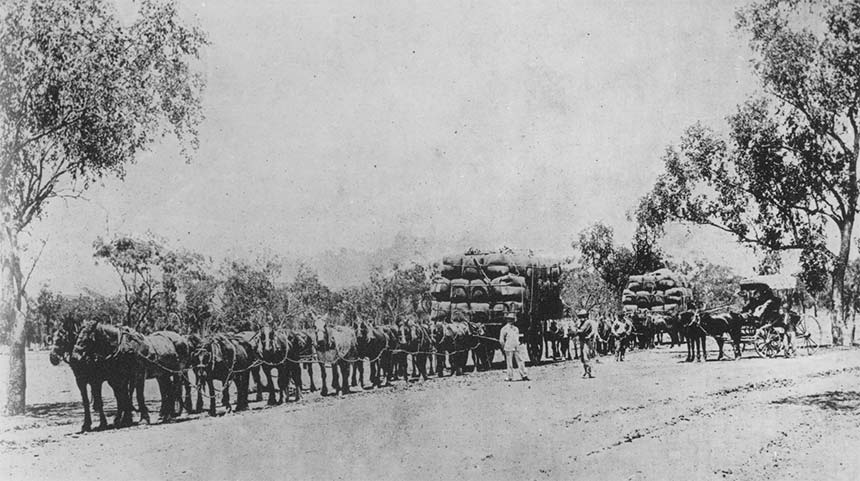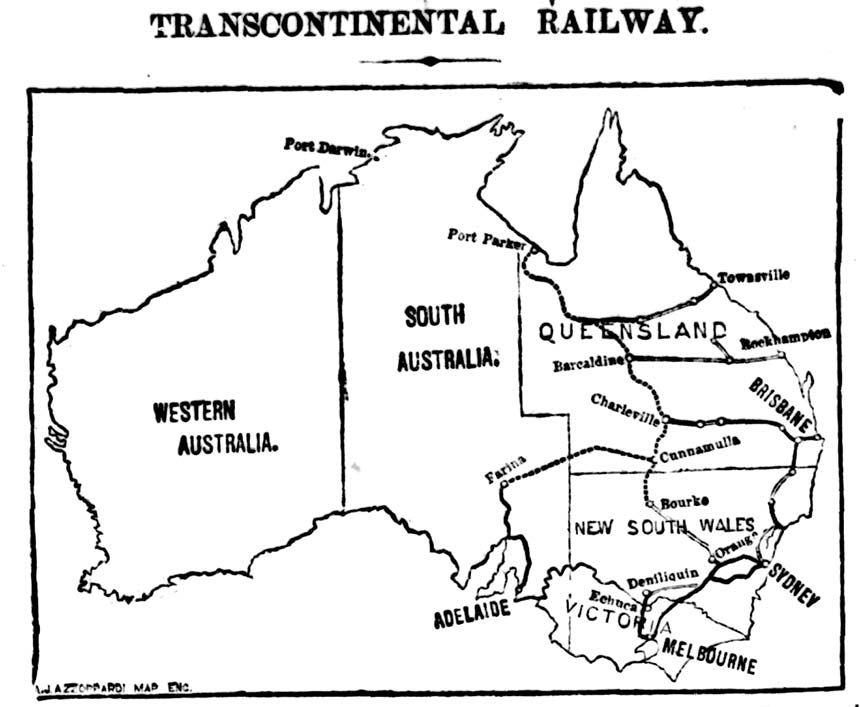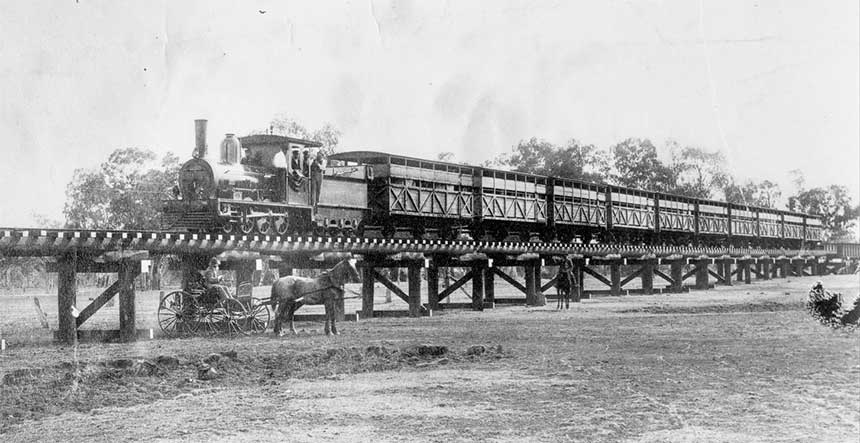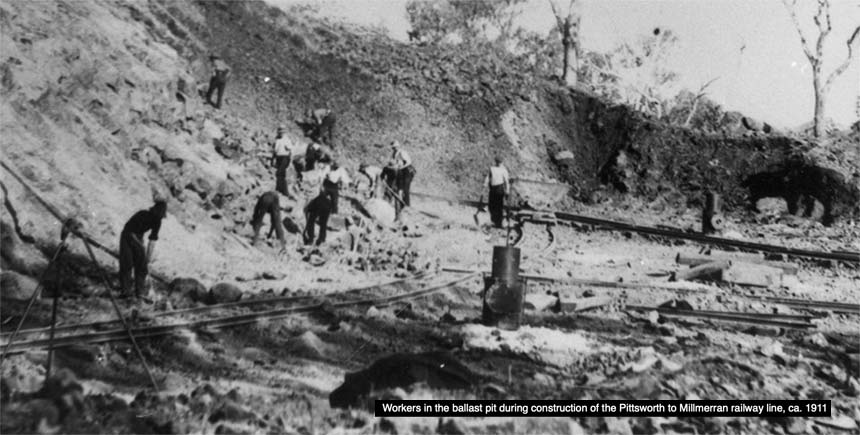RAILWAY BUILDING IN THE FAR WEST – CHARLEVILLE TOWARDS CUNNAMULLA.
The traveller who lounges on cushioned seat and grumbles if his train Is five minutes late, and who in any case is quite sure that the railway management is all wrong, seldom gives a thought to the men who build, maintain, and control the iron road. The mail train now runs 483 miles due west to Charleville, and probably before this time next year the iron horse will be snorting into Cunnamulla, 120 miles nearer to our Southern border.
The first section of the line, sixty-one miles in length, is now so far advanced that the contractor, Mr. G. C. Willcocks, hopes to hand it over by the end of May, and tenders for the remaining half will probably be invited in the course of a few weeks from tho present time.
This railway gives promise of being the cheapest line ever built for the Queensland Government, the contract price being £67,680, or £1109 per mile, the department finding nothing but rails and fastenings, while the contractor pays actual cost for conveyance of his material to the terminus of the existing line. What that may mean is illustrated by the fact that sleepers had to be conveyed from Cooran, on the North Coast Railway, 570 miles from Charleville, and others were brought from Miles, on the Western line, 202 miles distant.
All the supplies and plant had to be brought from Brisbane, so that freight alone becomes a heavy item. The work on No. 1 section was begun about the beginning of May last; but with the increasing heat of summer it was deemed best to give the men a spell, and accordingly work was suspended from 19th December till about the end of February. The line passes chiefly through mulga scrub, and the soil is similar in appearance to the red volcanic soil of the Eastern districts.
It is, however, closer in texture, and when broken up it turns to a fine powder, so that the men frequently work in clouds of dust. The country is for the most part level, with here and there an opening for the water and one bridge, which spans Angellala Creek. The mulga scrub, it should perhaps be explained, bears, no resemblance to what coast residents understand by the word. It consists of a dense growth of small and apparently dwarfed trees running to about 30ft in height, and having a diameter of not more than 6in. or 8in.
These trees for the most part present a very dismal appearance - not unlike the wattle in habit; all the lower branches are as a rule dead and leafless, whilst a thin and scattered foliage on the top shows that life has not altogether departed. The leaves furnish excellent feed for stock in droughty seasons. The first thing to be done in building a railway is, of course, to clear the road through these obstructions.
The trees are cut down and hauled clear of the line, and on the track itself the stumps have to be grubbed out - unless the bank is sufflcientlv high to make their presence harmless. Then the side cuttings are turned up with a plough, and after this follows a handy scoop similar to those used in tank-making. A strong team of horses drag the scoop through the ploughed ground till full, when they are driven across the track of the railway, and on reaching the centre the scoop is capsized in the required place, and the horses go forward to fill up again from the opposite side of the line.
Two teams working alternately from either side can get through the work most expeditiously. Mr. Willcocks has recently imported some most ingenious machinery for this work but it will not be used on the section now under construction. When the bunk has reached the required height it is levelled end rolled, a huge roller formed from a section of bridge cylinder being used for the purpose.
Then platelaying begins; rails, sleepers, and fastenings are brought along to the head of the line in tolleys, and the stipulated day’s work for the gang employed on this work is just half a mile. When that is performed their day’s work is done, and it is said that frequently they are able by good organisation and activity to get through quite early in the afternoon, and thus have the remainder of the day to themselves. As far as possible the earthwork is done by piece, and the men are thus their own masters, and work longer or shorter hours as may suit their convenience.
When the rails are laid the ballast waggons are pushed along, and here Mr. Wilcocks uses a very ingenious labour-saving contrivance. The waggons are of the hopper shape, like ordinary coal waggons, but the bottoms close with two shutters or doors operated from the side of the vehicle by means of a hand screw. As the trucks pass slowly over the line to be ballasted, men in attendance run along and open the doors as required. This secures an even distribution of the ballast, and none of it falls into the side ditches, as was the case with the old ballast waggons opening at the sides.
The last truck on the ballast train carries a steel plough with a double mouldboard spread out at such an angle as to cover the width of the track. This can be raised or lowered from the truck by means of screws, and the ballast is thus evenly spread with little or no hand labour. The remaining operations are similar to those ordinarily used in packing and straightening the line until a true and firm road is formed. On the Cunnamulla line the rails used are 30ft in length, thus requiring a less number of fastenings than ordinary, but rigidity is increased by a new pattern of fish- plate, as the connecting links are called.
This plate is almost a right-angle in section, grasping not only the perpendicular portion of the rall, but also the flange or bearing. Another peculiarity of this line is the substitution of concrete abutments and rolled steel girders for the ordinary wooden flood openings. These will prove much more durable than wood, while, owing to the scarcity of timber, the increase of cost is not nearly, so great as it would be in places nearer the coast As already stated, Angellala Creek Bridge is the most important work on the line. This is 17 miles from Charleville, the site of the contractor’s main camp.
The bridge will consist of one steel span 60ft. long, seven steel spans of 40ft. and sixteen timber spans, of which fourteen will have a length of 26ft, and two of 20ft. From the bed of the creek the structure will he 40ft. In height, carried on two solid concrete piers, the other supports being cast iron columns set in concrete foundations. At present the piers are nearing completion, and several of the girders have been delivered on the ground. Meanwhile the contractor’s engine crosses the creek on a temporary low-levèl bridge.
The first station on the new line will be Walall at the 17-mile. Mangalore, at 28 miles, is situated in an open plain, and here the line approaches to within fifty chains of the river, affording a convenient site for a pumping station. Accordingly a 22,000 gallon tank has been erected. The next station will be at Murweh, 38 miles, and the end of the section is at Wyandra, 60 miles, where also provision for watering will have to be made.
Generally speaking, the line follows the course of the Warrego River, but in order to avoid expense it has been kept away from the frontages, the distance from the main channel of the river varying from one to six miles. During the recent visit of Mr. Gray, Railway Cpmmissioner and Mr. Pagan, Acting Chief Engineer, the inspection carriage was run about fifty miles down the line, thus materially shortening their journey to Cunnamulla.
They were accompanied by Mr. Andrew Hoggan, resident engineer, under whose’ supervision the line is being built, and the contractor. The country generally was extremely dry, but rain had fallen in places, particularly towards the southern end of the line, and there was a slight spring in the grass. Stock appeared to be in first class condition, but grave fears were generally expressed as to extreme scarcity of feed and water during the winter. Every- where in South-western districts rain is earnestly desired., The men employed on the present contract number about 350, and the great distance from town, together with the trying nature of the work amidst a twofold plague of flies’ and dust makes it difficult to keep really good men. Mr. Willcocks has, however, an efficient staff, as the satisfactory progress indicates. Sickness has not been so severe as on some other lines, but many have suffered, from sore eyes. Cases requiring medical aid have been sent in to Charleville, and towards the support of the hospital, there the men have contributed most liberally.
They give 1s. per week from their wages, besides which special benefit was given some months ago, yielding £65 from the contractors and their men. Few, if any, women or children are to be seen on the line; but groups of tents, with a larger one for the mess, are found at intervals along the line. The work must be of an extremely trying nature, but good wages are made, and it is to be hoped the men are able to put by something by to the future of the district, the casual observer might wonder what there is for the railway to carry.
Not much, perhaps, in the present stage of development ; but even now it will improve the communication for a vast extent of country on all sides, and by making it easier to reach Charle- ville should assist in retaining the trade of the border districts for Queensland. It must also aid materially in the forward movement towards closer settlement and more economic use of natural resources. Admittedly there are large areas of fertile soil. All it needs, one is everywhere told, is water. Happily Nature has foreseen this want, and artesian supplies distributed by means of cheaply formed drains will make both grass and water for many thou- sands of sheep. The grazing farmer has come to stay ; he has come to show what can bo done by a more intensive system of husbandry, and his advent will largely aid in the success of such railways as that from Charleville to Cunnamulla.








